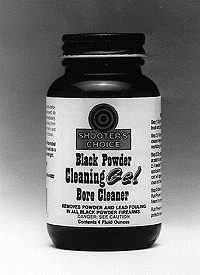|
Muzzle Blasts Online |
|
...for the muzzleloading enthusiast |
|
The muzzleblasts.com domain, subdomains, content, etc., are neither affiliated with the NMLRA nor its paper magazine Muzzle Blasts |
|
Muzzle Blasts Online |

|
|
|
|
|
|
Don't Trust a Clean Patch
This is a story about a good rifle that almost wound up in the junk pile, and about my continual learning experience with muzzleloaders. It all started several months ago when my son-in-law, Jimmy Simmons, decided that he might like to have a flintlock rifle. He'd been shooting caplocks for about a year and wanted a semi-custom gun like one of mine. He hadn't yet gotten the urge strong enough to pay $700 plus for one like mine, but I kept joking that only beginners, women, and children shoot caplocks. He should also have a barrel at least forty inches long; Daniel Boone would have been mortified to be caught with a twenty-eight inch barrel on his rifle.
Jimmy came across a couple of rifles at a gun shop. One was a .32 caliber flintlock Tennessee squirrel rifle by Dixie Gun Works that had been put together from a kit. It looked better than the factory finished product I'd seen, with fine wood-to-metal fit and several inlays. A spare frizzen, spare main spring, sixty swaged balls, and extra flints also came with it for what seemed like a bargain price.
I recommended to Jimmy that he buy the gun. If everything else failed, he could always put a new barrel on it, and someone who took this much trouble in putting a rifle together surely wouldn't abuse it. The frizzen gave off a shower of sparks anyone would be happy with, and that was even with a dull flint. My guess was that it had been shot forty times because there were sixty balls left in the box.
Jimmy followed my advice, and we went to the range for a try-out. He got a few fair groups, but nothing very special. I had similar results with it but didn't spend a lot of time because I have six flintlocks of my own that need shooting.
It wasn't long before Jimmy went back to his caplocks, and he didn't have anything nice to say about the thirty-two. He also didn't like the new sights I installed on it for him. Seems like three- or four-inch groups at 25 yards were about all he could expect.
I finally concluded that he'd had his fling with flintlocks; he probably had developed a bad flinch or something. This just reinforced my firm belief that sons-in-laws are a sorry lot unfit for my darling daughters. That is, except one who is a plumber, God bless him, and gives me all the lead I need.
I asked Jimmy if he had given up on the rifle. He assured me that he didn't have the time to mess with it and probably could be traded out of it.
We made a trade agreeable to both of us, and that was the beginning of my frustrations. Could it be that the Lord was punishing me for taking advantage of an innocent forty-six year old kid? Such thoughts went through my mind. I tried everything to make the gun shoot a decent group: different patch material, different lubes, and various powder charges. I tried a lapping the barrel with fine valve grinding compound on a patch run back and forth in the bore many times. The bore didn't really feel rough, but it wasn't slick either. My friend Jimmy Craig recrowned the muzzle, even though you couldn't see anything wrong with it. Once in a while the rifle would produce a three-shot 1 1/2-inch group at 25 yards. But usually it was three or four inches. Of course the bore was always cleaned between shots.
I gave up messing with this piece of junk and started making plans to install a .40 caliber Green Mountain barrel.
So I unbreeched the barrel to determine breech plug size, and believe me, it didn't come out easy. As I'd expected, the plug was 9/16 by 18, so this meant a new plug for the new barrel and more work to drill the new tang and fit it to the stock. I passed a couple of wet cleaning patches through the barrel although the gun was clean when it left the range the last time. Patches came out white as snow - just wanted to be sure before adding a heavy coat of oil and standing it in the corner forever. I hadn't yet looked down the barrel, as the whole point of this activity was to check the breech plug size.
Just before switching to an oiled patch, I held the barrel up to the light to have a look. What I saw was streaked, splotched, and splattered areas of dark gray fouling from the breech to the muzzle. My first thought was: my God, that must be lead, but how can this be? I'd always picked up enough patches down range to make sure they weren't being blown, but somehow and by somebody this barrel had gotten leaded, but good.
On my shelf was a bottle of Black Powder Cleaning Gel Bore cleaner made by Shooter's Choice that was supposed to remove black powder fouling and lead. I'd won it at a match years ago but never used it because my water-based cleaners worked fine, and with patched roundballs, who worried about lead fouling? The normal Shooter's Choice cleaner had always done well on my cartridge rifles to remove copper fouling. Anyway, a few strokes with a bronze brush dipped in this stuff and then the same treatment with a wet patch around the brush, and the bore shone like new money, just like a barrel's supposed to shine.

|
|
If you shoot lead bullets it might be worthwhile to occasionally brush the bore with a proven lead solvent. |
Since then I've been wondering how many rifles are standing in corners or in closets because the owners got disgusted with the poor accuracy. With the current increased interest in primitive firearms and hunting, and the tendency to shoot lead bullets (unpatched) or even sabot-encased bullets, this isn't such a far-fetched assumption. Fouling with plastic from sabots is an entirely different problem that could probably also stand some study. This might be a good subject for the Bevel Brothers.
Probably the best advice you could give for avoiding a leaded barrel would be to check patches that have been shot and make sure they're in one piece, with no holes. This is especially true if you change patch material or increase powder charge. If you shoot lead bullets it might be worth- while to occasionally brush the bore with a proven lead solvent like I mentioned above. Our good water based cleaning solutions won't touch lead, and we go happily along believing that our bores are spotless.
Henceforth I'm going to make every effort to be sure that all the lead I shoot is going down range.